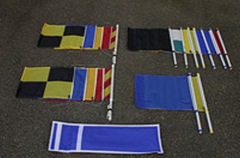In one of the comments on Helping Hands, Pat of Desert Sea - New Mexican Sailing asked about the use of the red flag in Match Racing.
Because it's not often used, there is - also among umpires - a lot of misunderstanding about when to apply it. First let me explain what it means. The red flag always has to be used by umpires together with a blue or yellow flag, never as a single flag. When red and blue are held up together it signals the blue boat they are penalized AND that they have to take the penalty as soon as reasonably possible, but not before starting. A normal blue penalty can be postponed until the blue boat thinks it is the best place or just before finishing. Not if the red flag is used. Then the blue boat has to take it directly!
You can classify this penalty as a little more than a 'normal' penalty, but a little less than a double penalty
| signal | penalty | |
| 1 | colored flag (Y or B) | may be postponed |
| 2 | colored + red flag | shall taken as soon as reasonably possible |
| 3 | two colored flags | one may be postponed, second penalty shall be taken a.s.a. reasonably possible |
| 4 | three colored flags = colored + black flag | DSQ |
When do you use a red flag:
From the ISAF Umpires and Match Racing Manual 5 Part B - Edition 6/05
Sometimes breaking a rule and getting penalized leaves a boat in a better position than she would have been if she had not broken a rule. In such cases the umpires have several options:
- To give the penalty as a red flag penalty (C5.3).
- To give an additional, umpire initiated penalty (C5.2)
- To display a black flag (C5.4).
A brief delay in making a decision may be justified when judging whether a boat has gained control by breaking a rule. The umpires may want to give the boat a red flag penalty if she has gained control. (C5, C6.5(b) and C7.3(d)). The additional, umpire initiated penalty is meant to take away an advantage gained by a boat that broke a rule, especially if that advantage was gained through a deliberate breach of a rule at a critical time e.g. breaking a rule to avoid being OCS, barging at the start and denying an inside boat room at the mark. It may also be given to a boat that commits a breach of sportsmanship, and in such a case, the umpires may initiate the penalty without any flag Y from a competitor. (C8.3 and CALL MR 31)
Many umpires have been reluctant to give a boat two penalties. Often, two penalties given for one incident early in the match meant the end of any real competition between the boats. The boat that was penalized was several boat lengths behind and did not have a chance to catch up while sailing in the other’s control and in its bad air. A match for whom there is no hope of winning is boring for all concerned. However, it is important that when the conditions for an additional umpire initiated penalty have been fulfilled, the umpires give such a penalty. The sailors do take 'calculated risks' - they barge in at the start and expect to either get away with it, or to get a red flag penalty. In case of a red flag penalty under such circumstances, the outcome is that the sailor will have to take a penalty and after the penalty will find himself in the same spot as before the incident - but with no outstanding penalty. With a double penalty, the boat gets back to where she would have been without the breach, but she also has to carry a penalty for the breach.

When the umpires judge that a boat has gained control as a result of breaking a rule, but they are not certain that the conditions for an additional umpire initiated penalty have been met, they display a red flag with or soon after the penalty flag. The boat that gets the red flag penalty must take the penalty as soon as reasonably possible. If one boat has a penalty and the other receives a red flag penalty, the red flag penalty
does not cancel the outstanding penalty. (C7.2(e))
The red flag penalty is designed to restore the relative positions of the boats before the incident that resulted in the penalty. It does not relieve the other boat of an outstanding penalty the way that a double penalty (two penalties for the same incident) would.
If, after a boat has completed a red flag penalty, she still has an advantage, and the requirements in C6.5(b) are fulfilled, the umpires may give her another penalty, and this could be another red flag penalty. (C8.3)


0 comments:
Post a Comment